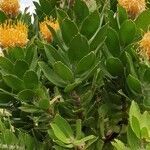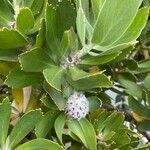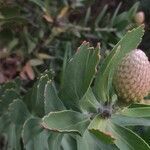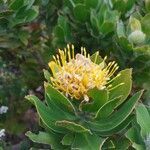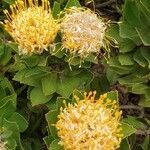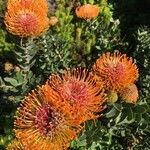An erect to spreading, rounded shrub, to 1.5 m in diam., with a single main stem. Flowering stems erect, slender, 3.0-5.0 mm in diam., villous. Leaves sessile, sub-imbricate, erect-ascending ovate elliptic 2.5-4.5 cm long, 0.75-1.5 mm wide; apex acute to obtuse usually entire, rarely bifid or trifid; glabrous, occasionally puberulous when young. Inflorescences numerous, up to 8 inflorescences per flowering shoot; depressed globose 2.0 cm in diam., pedunculate, peduncle, 1.0 cm long, 2.0 mm in diam., lanate. Involucral receptacle flat, 5.0-7.0 mm wide. Involucral bracts ovate-acute, 4.0-5.0 mm long, 2.0 mm wide, glabrescent with ciliate margins, reddish carmine in fresh state, texture soft and membranous; imbricate, aggregated to form a distinct cup-shaped involucre of about 3 whorls. Bracteoles lanceolate-acuminate, 7.0 mm long, 1.5 mm wide, densely villous to lanate, medianly canaliculate on inner surface. Perianth straight in bud, 2.0 mm long, creamy-white, becoming very pale pink with age. Perianth tube 5.0 mm long, glabrous proximally, puberulous distally, slightly quadrangular. Perianth claws densely villous, deflexed subterminally. Perianth limbs broadly lanceolate, 1.0 mm long, villous, reddish on outer surface when fresh. Style 1.5-2.0 cm long, straight, tapering subterminally. Pollen presenter conic ovoid, 0.75-1.0 mm long, pale greenish-yellow. Hypogynous scales hyaline, filiform, 1.0 mm long.
Rounded, spreading shrub to 1.5 m. Leaves ovate-cordate, glabrescent, with 1-6 apical teeth. Flower heads depressed-globose, 100-120 mm diam., orange-scarlet, style spreading-incurved, 45-60 mm long, pollen presenter globose and obliquely truncate.
